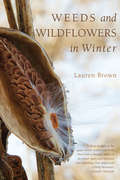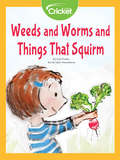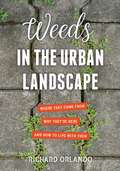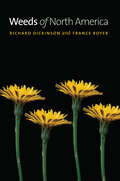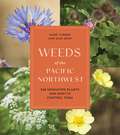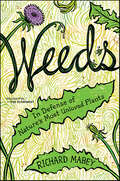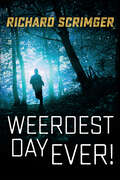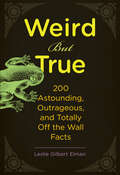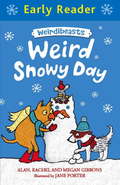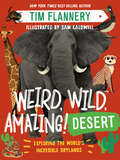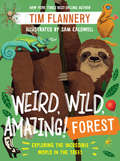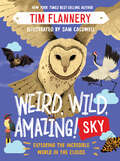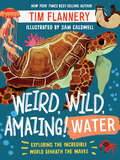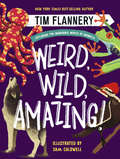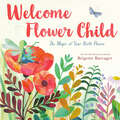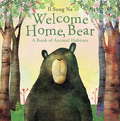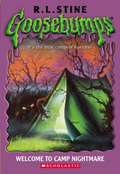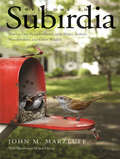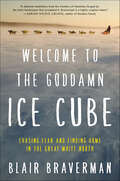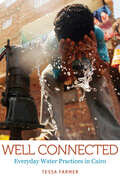- Table View
- List View
Weeds and Wildflowers in Winter
by Lauren BrownThe help you need identifying the dormant but visible vestiges of spring and summer wildflowers and other plants. When it was first published, Roger Tory Peterson said of Weeds and Wildflowers in Winter (originally published as Wildflowers and Winter Weeds), "this book will be a joy to those wood-walkers and strollers who have been puzzled by the skeletal remains of herbaceous plants that they see in winter." And indeed, it has been in print for decades, helping both wood-walkers and botanists identify and better understand the weeds we see in winter. This charming guide identifies more than 135 common species of wildflowers and weeds found in the northeastern United States. Each plant is superbly illustrated with a full-page drawing accompanied by an elegant description of the plant's key characteristics. In addition, a step-by-step key to plant identifications and an illustrated glossary of common plant parts and botanical terms make this book an even more valuable resource. If you've ever wanted to know what those plants you see sticking up out the snow are, you'll appreciate this lovely, useful book.
Weeds and Worms and Things That Squirm
by Gail ParkerWhat kinds of plants grow in the garden? Carrots, radishes, and … a furry plant?
Weeds in the Urban Landscape: Where They Come from, Why They're Here, and How to Live with Them
by Richard OrlandoA comprehensive identification guide to 189 common weeds in the urban environment, explaining their families and characteristics, with strategies for managing their presence in the garden and fieldsThis engaging field guide for the urban explorer, gardener, or armchair enthusiast traces the history of weeds as they migrated out of the Middle East with human tribes and spread across Europe and the Americas, details the folklore surrounding them, and explains their role in the evolution of agriculture and human civilizations as well as their many uses for medicine, food, animal fodder, and soil enhancement. Richard Orlando provides detailed descriptions of 189 common weeds—found across the U.S.—describing their families and characteristics, and suggesting strategies for managing their presence in the garden and field. Abundant illustrations enhance the text and facilitate plant identification. An annotated bibliography and index of botanical names, in addition to a detailed explanation of Integrated Pest Management, make this an essential reference for anyone with an interest in the world outside our doors.
Weeds of North America
by France Royer Richard DickinsonAmerican Horticultural Society Book Award Winner: “An essential reference for all who wish to understand the science of the all-powerful weed.” —Better Homes and Gardens“What is a weed,” opined Emerson, “but a plant whose virtues have not yet been discovered?” While that may be a worthy notion in theory, these plants of undiscovered virtue cause endless hours of toil for backyard gardeners. Wherever they take root, weeds compete for resources, and most often win. They also wreak havoc on industry—from agriculture to golf courses to civic landscape projects, vast amounts of money are spent to eradicate these virile and versatile invaders. With so much at stake, reliable information on weeds and their characteristics is crucial. Richard Dickinson and France Royer shed light on this complex world with Weeds of North America.Organized by plant family, this encyclopedic volume features over five hundred species in two-page spreads with images and text identification keys. Species are arranged within family alphabetically by scientific name, and entries include vital information on seed viability and germination requirements. No matter what your philosophy on weeds, this guide provides much-needed background on these intrusive organisms. In the battle with weeds, knowledge truly is power, and Weeds of North America is perfect for gardeners, botanists, nature lovers, or anyone working in the business of weed ecology and control.“Royer’s photographs are almost perversely alluring. . . . How can you not be ensnared by a book populated by prostrate pigweed, tansy ragwort and dog-strangling vine?” —New York Times Book Review
Weeds of the Pacific Northwest: 368 Unwanted Plants and How to Control Them
by Mark Turner Sami GrayA comprehensive guide to the most common weeds of the Pacific Northwest, with essential information on their management and eradication Weeds are everywhere. They crowd out valuable agricultural crops, compete with the tomatoes and beans in your vegetable garden, spread rampantly along roadsides, and pop up from the tiniest cracks in sidewalks. In order to manage them, we must first learn how to identify them. Weeds of the Pacific Northwest is a guide to identifying, controlling, and eradicating over 300 species of weeds that gardeners and homeowners are likely to encounter in Northern California, Oregon, Washington, and British Columbia. Though they can all cause trouble, each weed is different. The hundreds of user-friendly photographs and detailed descriptions of each species here ensure that you can spot and treat any weed in your path. As the experts behind this book demonstrate, some plants can be killed by eating them, some by digging, some by smothering, and some only by the judicious application of chemical herbicides—and it is very important for you and your neighbors to know and understand the differences.
Weeds: In Defense of Nature's Most Unloved Plants
by Richard Mabey“[A] witty and beguiling meditation on weeds and their wily ways….You will never look at a weed, or flourish a garden fork, in the same way again.”—Richard Holmes, author of The Age of Wonder“In this fascinating, richly detailed book, Richard Mabey gives weeds their full due.”—Carl Zimmer, author of EvolutionRichard Mabey, Great Britain’s Britain’s “greatest living nature writer” (London Times), has written a stirring and passionate defense of nature’s most unloved plants. Weeds is a fascinating, eye-opening, and vastly entertaining appreciation of the natural world’s unappreciated wildflowers that will appeal to fans of David Attenborough, Robert Sullivan’s Rats, Amy Stewart’s Wicked Plants, and to armchair gardeners, horticulturists, green-thumbs, all those who stop to smell the flowers.
Weekend Handmade: More Than 40 Projects and Ideas for Inspired Crafting (Weekend Craft Ser.)
by Kelly Wilkinson&“Weekend Handmade provides instructions for quirky crafts that virtually anyone can do . . . Think hipster Martha Stewart&” (NPR Weekend Edition). In Weekend Handmade, author Kelly Wilkinson encourages readers to celebrate the joy of crafting, both for the satisfaction of making something by hand, and because the finished items serve as reminders of time taken to slow down and create—no matter the day of the week. The book is organized into three sections: &“Make&” offers projects to wear or decorate with; &“Grow&” presents projects inspired by gardens, fields, and farmer&’s markets; and &“Gather&” spotlights projects that enrich casual get-togethers. With clear, step-by-step instructions, every project in Weekend Handmade—from aprons, tablecloths, and marmalade to a memory box and a chandelier—can be completed in a few hours or over the course of a weekend. &“Think you can&’t make anything—or, more importantly, that you don&’t have the time to? Wilkinson&’s undowdy projects—luminarias, table decorations—are all designed to be completed in a couple of hours.&” —Entertainment Weekly
Weerdest Day Ever! (The Seven Prequels #4)
by Richard ScrimgerBunny is on a camping trip with his brother and his grandpa. How much trouble can he get into? As it turns out, a lot. For one thing, there are soldiers all over the place. Canada is about to go to war with the United States, and the battle starts tomorrow. Bunny is worried. A hockey rivalry is one thing, but this is serious. And why is everybody so happy? Things get personal when an American soldier steals his brother Spencer's cell phone. Bunny decides to track down the phone himself. Maybe they can get out of there before the war starts. That’s when things get confusing. . . In this zany prequel to Ink Meand The Wolf and Me, the hockey-loving, indomitable Bunny goes camping with his brother and his grandpa.
Weighting Methods and their Effects on Multi-Criteria Decision Making Model Outcomes in Water Resources Management
by Noorul Hassan Zardari Kamal Ahmed Sharif Moniruzzaman Shirazi Zulkifli Bin YusopThis book provides a systematic way of how to make better decisions in water resources management. The applications of three weighting methods namely rating, ranking, and ratio are discussed in this book. Additionally, data mining on keywords is presented using three popular scholarly databases: Science Direct, Scopus, and SciVerse. Four abbreviated keywords (MCDM, MCDA, MCA, MADM) representing multi-criteria decision-making were used and these three databases were searched for different popular weighting methods for a period of 13 years (2000-2012). The book provides also a review of weighting methods applied in various multi-criteria decision-making (MCDM) methods and also presents survey results on priority ranking of watershed management criteria undertaken by 30 undergraduate and postgraduate students from the Faculty of Civil Engineering, Universiti Teknologi Malaysia.
Weird But True: 200 Astounding, Outrageous, and Totally Off the Wall Facts
by Leslie Gilbert ElmanBizarre and fascinating facts for fans of science, nature, history, and more!The Earth is broadcasting a symphony of sound right now . . . Madagascar is home to enormous suicidal palm trees . . . Blacktip sharks can reproduce by virgin birth . . . In this fascinating book, weird, true facts like these reveal just how much freaky stuff really happens around the world.We’ve uncovered odd natural phenomena, super-strange historic occurrences, downright bizarre momentous discoveries, and totally peculiar coincidences that will blow your mind. From Biblical latrines to ultimate survivor microbes, if it’s weird—and true—you’ll find it here!
Weird Snowy Day: Book 4 (Weirdibeasts #4)
by Alan Gibbons Rachel Gibbons Megan GibbonsA full colour blue Early Reader story from million-copy-selling author Alan Gibbons writing with his daughters, Megan and Rachel.Early Readers are stepping stones from picture books to reading books perfect for building confidence in new readers and reluctant readers. A blue Early Reader is perfect for sharing and reading together. A red Early Reader is the next step on your reading journey.Katie Cat saw it first. It was a single white flake drifting down from the sky. It's a snowy day, and that means snowball fights and playing outside with friends. Even the littlest animals can have fun in the snow.A delightful new Weirdibeasts story from million-copy-selling author Alan Gibbons writing with his daughters, Megan and Rachel, and illustrated by Jane Porter.
Weird, Wild, Amazing! Desert: Exploring the World's Incredible Drylands
by Tim FlanneryInternationally renowned author and scientist Tim Flannery explores Earth’s deserts and grasslands and the extraordinary animals that live in them. Are zombie ants real? How high can an armadillo jump? What’s it like to wrestle a python? Tim Flannery has the answers. In this informed and accessible book, he introduces some of the most spectacular and unusual creatures in our planet’s deserts and grasslands with in-depth and often-bizarre facts. Flannery ties together concepts of climate change, evolution, conservation, and taxonomy throughout each animal’s profile, firmly connecting it to its environment while sparking wonder at its role in the natural world. Packed with vibrant illustrations and guided by real-life anecdotes from one of our greatest science communicators, Weird, Wild, Amazing! Desert teaches readers to cherish and delight in our planet’s ecosystems with Flannery’s signature mix of humor and wisdom.
Weird, Wild, Amazing! Forest: Forest
by Tim FlanneryInternationally renowned author and scientist Tim Flannery explores our planet’s forests and the extraordinary animals that live in them. Can spiders fly? Are dire wolves real? Do chameleons practice magic? Tim Flannery has the answers. In this informed and accessible book, he introduces some of the most spectacular and unusual creatures in Earth’s forests with in-depth and often bizarre facts. Flannery ties together concepts of climate change, evolution, conservation, and taxonomy throughout each animal’s profile, firmly connecting the animal to its environment while sparking wonder at its role in the natural world. Packed with vibrant illustrations and guided by real-life anecdotes from one of our greatest science communicators, Weird, Wild, Amazing! Forest teaches readers to cherish and delight in our planet’s ecosystems with Tim Flannery’s signature mix of humor and wisdom.
Weird, Wild, Amazing! Sky: Exploring the Incredible World in the Clouds
by Tim FlanneryInternationally renowned author and scientist Tim Flannery takes readers to the skies to learn about the extraordinary animals that fly in them. Can owls swim? Do woodpeckers eat wood? Are vampire bats real? Tim Flannery has the answers. In this informed and accessible book, he introduces some of the most spectacular and unusual creatures soaring through Earth’s skies with in-depth and often-bizarre facts. Flannery ties together concepts of climate change, evolution, conservation, and taxonomy throughout each animal’s profile, firmly connecting it to its environment while sparking wonder at its role in the natural world. Packed with vibrant illustrations and guided by real-life anecdotes from one of our greatest science communicators, Weird, Wild, Amazing! Sky teaches readers to cherish and delight in our planet’s ecosystems with Flannery’s signature mix of humor and wisdom.
Weird, Wild, Amazing! Water: Water
by Tim FlanneryInternationally renowned author and scientist Tim Flannery explores our planet’s rivers and oceans and the extraordinary animals that live in them. Can jellyfish become zombies? Are narwhals unicorns? Can a turtle live in a tree? Tim Flannery has the answers. In this informed and accessible book, he introduces some of the most spectacular and unusual creatures in Earth’s waters with in-depth and often bizarre facts. Flannery ties together concepts of climate change, evolution, conservation, and taxonomy throughout each animal’s profile, firmly connecting it to its environment while sparking wonder at its role in the natural world. Packed with vibrant illustrations and guided by real-life anecdotes from one of our greatest science communicators, Weird, Wild, Amazing! Water teaches readers to cherish and delight in our planet’s ecosystems with Tim Flannery’s signature mix of humor and wisdom.
Weird, Wild, Amazing!: Exploring The Incredible World Of Animals
by Tim FlanneryInternationally renowned author and scientist Tim Flannery’s first children’s book is a humorous, informed, and accessible deep-dive into the natural world. Are zombie jellyfish real? Do frogs like opera? What’s it like to wrestle a python? Tim Flannery has the answers. Introducing some of the most spectacular and unusual creatures on Earth, from water to sky and the forests and deserts in between, he offers in- depth and often bizarre facts on extraordinary animals that live in each habitat while incorporating concepts of climate change, evolution, conservation, and taxonomy. Did you know that lions once roamed North America, or that albatrosses sleep-fly? Have you ever heard a piranha bark, or ever wondered how the sloth got its name? Packed with vibrant illustrations and guided by real-life anecdotes from one of our greatest science communicators, Weird, Wild, Amazing! teaches readers to cherish and delight in our planet’s environment with Flannery’s signature mix of humor and wisdom.
Welcome Flower Child: The Magic of Your Birth Flower
by Brigette BarragerA beautiful gift book that reveals the meaning of birth flowers for babies born each month of the year.Every child is a different kind of flower, and all together, make this world a beautiful garden.Welcome to this celebration of nature and babies from New York Times bestselling illustrator of Uni the Unicorn, Brigette Barrager. A gorgeous gift book reveals the qualities of babies born in each month of the year, and the accompanying flower that blooms in each birth month. This text is sweet, and soft, and everyone who opens it can find the special personality traits of individuals born in their month revealed.
Welcome Home, Bear: A Book of Animal Habitats
by Il Sung NaFollow Bear as he visits animal habitats around the world--and comes to appreciate his own home--in this new offering from the creator of A Book of Sleep and A Book of Babies. Bear is tired of waking up every morning in the same green forest, so he decides to search for a new place to live. He visits the birds in the trees, a mole underground, a camel in the hot desert sand, puffins in the cold arctic snow . . . only to realize his own home is the perfect place for him after all. Welcome Home, Bear offers rich illustrations, bright colors, and a simple, spare text--all wrapped up in a beautiful, kid-friendly package. Readers meet animals in their habitats around the world--and return with Bear to the one place he is truly happy.
Welcome to Camp Nightmare (Goosebumps #9)
by R. L. StineNext Summer you'll stay at home. . . if you survive! The food isn't great. The counselors are a little strange. And the camp director, Uncle Al, seems sort of demented. Okay, so Billy can handle all that. But then his fellow campers start to disappear. What's going on? Why won't his parents answer his letters? What's lurking out there after dark? Camp Nightmoon is turning into Camp Nightmare! And Billy might be next. . . .
Welcome to Subirdia
by John M. Marzluff Jack DelapWelcome to Subirdia presents a surprising discovery: the suburbs of many large cities support incredible biological diversity. Populations and communities of a great variety of birds, as well as other creatures, are adapting to the conditions of our increasingly developed world. In this fascinating and optimistic book, John Marzluff reveals how our own actions affect the birds and animals that live in our cities and towns, and he provides ten specific strategies everyone can use to make human environments friendlier for our natural neighbors. Over many years of research and fieldwork, Marzluff and student assistants have closely followed the lives of thousands of tagged birds seeking food, mates, and shelter in cities and surrounding areas. From tiny Pacific wrens to grand pileated woodpeckers, diverse species now compatibly share human surroundings. By practicing careful stewardship with the biological riches in our cities and towns, Marzluff explains, we can foster a new relationship between humans and other living creatures-one that honors and enhances our mutual destiny.
Welcome to the Goddamn Ice Cube: Chasing Fear and Finding Home in the Great White North
by Blair BravermanA rich and revelatory memoir of a young woman reclaiming her courage in the stark landscapes of the north.By the time Blair Braverman was eighteen, she had left her home in California, moved to arctic Norway to learn to drive sled dogs, and found work as a tour guide on a glacier in Alaska. Determined to carve out a life as a “tough girl”—a young woman who confronts danger without apology—she slowly developed the strength and resilience the landscape demanded of her. By turns funny and sobering, bold and tender, Welcome to the Goddamn Ice Cube brilliantly recounts Braverman’s adventures in Norway and Alaska. Settling into her new surroundings, Braverman was often terrified that she would lose control of her dog team and crash her sled, or be attacked by a polar bear, or get lost on the tundra. Above all, she worried that, unlike the other, gutsier people alongside her, she wasn’t cut out for life on the frontier. But no matter how out of place she felt, one thing was clear: she was hooked on the North. On the brink of adulthood, Braverman was determined to prove that her fears did not define her—and so she resolved to embrace the wilderness and make it her own. Assured, honest, and lyrical, Welcome to the Goddamn Ice Cube paints a powerful portrait of self-reliance in the face of extraordinary circumstance. Braverman endures physical exhaustion, survives being buried alive in an ice cave, and drives her dogs through a whiteout blizzard to escape crooked police. Through it all, she grapples with love and violence—navigating a grievous relationship with a fellow musher, and adapting to the expectations of her Norwegian neighbors—as she negotiates the complex demands of being a young woman in a man’s land.Weaving fast-paced adventure writing and ethnographic journalism with elegantly wrought reflections on identity, Welcome to the Goddamn Ice Cube captures the triumphs and the perils of Braverman’s journey to self-discovery and independence in a landscape that is as beautiful as it is unforgiving.
Welcome to the Jungle
by Matt LondonWHAT IF YOU BUILT A CONTINENT OF YOUR OWN? AND WHAT IF IT WAS ON A COLLISION COURSE WITH AUSTRALIA?Rick and Evie Lane have finally converted the Great Pacific Garbage Patch into an eighth continent. But their dream of a new homeland for their family turns out to be short-lived. Because when robots from the villainous Condo Corp crash into their continent, a fatal oversight in the building process is revealed: the land mass was never anchored to the ocean floor!Now, the eighth continent is sent barreling toward the coast of Australia, thrusting Rick and Evie's dreams, 23 million people, and countless plants and animals into jeopardy. If Rick and Evie are ever to get their family back together and have a continent to run--and not run after--they must find a way to root their beloved paradise to the Earth's crust. Or else everything that they built will go pow like Pangaea!BUILD IT - RUN IT - RULE ITat 8thContinentBooks.com
Well Connected: Everyday Water Practices in Cairo (Water and Society)
by Tessa FarmerHow a community in Cairo, Egypt, has adapted the many systems required for clean water.Who is responsible for ensuring access to clean potable water? In an urbanizing planet beset by climate change, cities are facing increasingly arid conditions and a precarious water future. In Well Connected, anthropologist Tessa Farmer details how one community in Cairo, Egypt, has worked collaboratively to adapt the many systems required to facilitate clean water in their homes and neighborhoods.As a community that was originally not included in Cairo's municipal systems, the residents of Ezbet Khairallah built their own potable water and wastewater infrastructure. But when the city initiated a piped sewage removal system, local residents soon found themselves with little to no power over their own water supply or wastewater removal. Throughout this transition, residents worked together to collect water at the right times to drink, bathe, do laundry, cook, and clean homes. These everyday practices had deep implications for the health of community members, as they struggled to remain hydrated, rid their children of endemic intestinal worms, avoid consuming water contaminated with sewage, and mediate the impact of fluctuating water quality. Farmer examines how the people of Cairo interact with one another, with the government, and with social structures in order to navigate the water systems (and lack thereof) that affect their day-to-day lives. Farmer's extensive ethnographic fieldwork during the implementation of the Governorate of Cairo's septic system shines through in the compelling stories of community members. Well Connected taps into the inherent sociality of water through social contacts, moral ideology, interpersonal relationships, domestic rhythms, and the everyday labor of connecting.
Well-being, Sustainability and Social Development: The Netherlands 1850–2050
by Harry Lintsen Frank Veraart Jan-Pieter Smits John GrinThis open access book examines more than two centuries of societal development using novel historical and statistical approaches. It applies the well-being monitor developed by Statistics Netherlands that has been endorsed by a significant part of the international, statistical community. It features The Netherlands as a case study, which is an especially interesting example; although it was one of the world’s richest countries around 1850, extreme poverty and inequality were significant problems of well-being at the time. Monitors of 1850, 1910, 1970 and 2015 depict the changes in three dimensions of well-being: the quality of life 'here and now', 'later' and 'elsewhere'. The analysis of two centuries shows the solutions to the extreme poverty problem and the appearance of new sustainability problems, especially in domestic and foreign ecological systems. The study also reveals the importance of natural capital: soil, air, water and subsoil resources, showing their relation with the social structure of the ‘here and now´. Treatment and trade of natural resources also impacted on the quality of life ‘later’ and ‘elsewhere.’ Further, the book illustrates the role of natural capital by dividing the capital into three types of raw materials and concomitant material flows: bio-raw materials, mineral and fossil subsoil resources. Additionally, the analysis of the institutional context identifies the key roles of social groups in well-being development. The book ends with an assessment of the solutions and barriers offered by the historical anchoring of the well-being and sustainability issues. This unique analysis of well-being and sustainability and its institutional analysis appeals to historians, statisticians and policy makers.
Wellbeing, Justice and Development Ethics
by Severine DeneulinThe question of the meaning of progress and development is back on the political agenda. How to frame this discontent and search for new alternatives when either Marxism or liberalism no longer provides a satisfactory framework? This book introduces in an accessible way the capability approach, first articulated by Amartya Sen in the early 1980s. Written for an international audience, but rooted in the Latin American reality - a region with a history of movements for social justice - the book argues that the capability approach provides to date, the most encompassing and compelling ethical framework with which to construct action for improving people’s wellbeing and reducing injustices in the world. This book outlines in a clear and concrete way what the capability approach is and its significance for the social sciences and policy. It describes the distinctiveness of the approach as an ethical framework for action and aims to stimulate critical reflection on current economic and social practices as well as providing a language with which to modify them within human wellbeing concerns. Comprehensive, practical and nuanced in its treatment of the capability approach, this highly original volume gives students, researchers and professionals in the field of development an innovative framing of the capability approach as a 'language' for action and provides specific examples of how it has made a difference.
